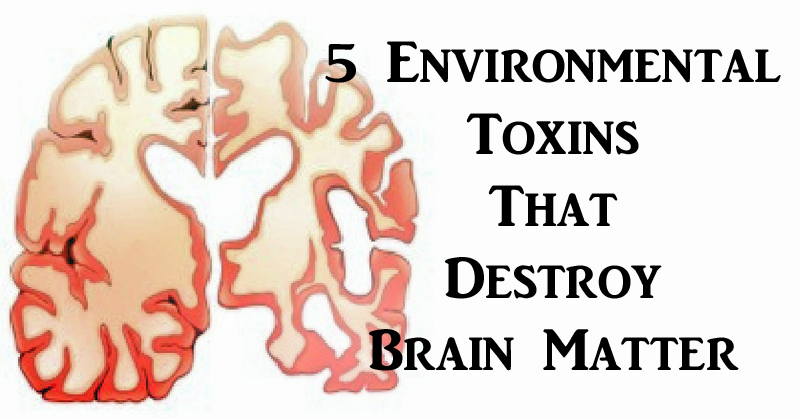It’s no secret that we’re living in a world of toxins. But if you’re unaware of exactly how dangerous these toxins are to our health, you might want to sit down for this. Dr. David Bellinger, a professor of neurology at Harvard Medical School, estimated that Americans have collectively lost around fourty-one million IQ points thanks to environmental toxins.
Bellinger compared intelligence levels among children whose mothers had been exposed to neurotoxins while pregnant, versus children whose mothers had not been exposed while pregnant. His results showed a total loss of 16.9 million IQ points. This was largely due to exposure of the most common pesticides used in agriculture, known as organophosphates. Bellinger and other experts believe that a number of toxins are damaging the brains of unborn children. They are lowering IQ’s and causing ADHD and autism spectrum disorder. These researchers believe that “children worldwide are being exposed to unrecognized toxic chemicals that are silently eroding intelligence, disrupting behaviors, truncating future achievements and damaging societies.” (1)

So what toxins are we talking about?
1. Arsenic
Ground water riddled with arsenic affects around 750,000 people, many in South Asia. Arsenic is a semi-metallic element that occurs naturally in the earth’s crust, but exposure is a problem. Human exposure is causing cancer, blood vessel damage, abnormal heartbeat and other illnesses. Arsenic posioning affects the skin, liver, lungs and kidneys, and can eventually lead to death. Exposure to arsenic while pregnant can lead cause a miscarriage or birth defects. Children who are exposed to arsenic for a long period of time may have a diminished IQ. (2)
2. Pesticides
Phillipe Grandjean, a Harvard colleague of Bellinger’s, urges pregnant women to eat organic food. He estimates that there are about 45 organophosphate pesticides on the market, and he says that most of them have the potential to damage a developing nervous system. An organophosphate pesticide called chlorpyrifos was the most widely used insect killer in American homes until 1995. That year, the EPA fined Dow Chemical for hiding more than 200 reports of poisoning cases. Today, the pesticide is considered “moderately toxic” to mammals, but it is still widely used in agriculture. Eating organic while pregnant can reduce the exposure of these pesticides to an unborn child by 80 or 90 percent. (3)
3. Lead
Before we knew about the damaging effects of lead, companies used lead in gasoline, children’s toys, house paints, batteries, and even cosmetics. By the 1970’s, 88% of children suffered from high levels of lead in their blood. In fact, it was up to twice the toxic level. Environmental contamination includes mining, smelting and manufacturing. Lead exposure can affect nearly every part of the body, causing permanent damage to the brain and the nervous system. Specifically, lead affects brain development in children, causing a lower IQ, reduced attention span and severe antisocial behavior. Both the neurological and behavioral effects of lead poisoning are believed to be irreversible. (4)
4. Mercury
High levels of mercury in the air often originate from power plants run by coal. Many of these power plants are located very close to urban areas and cities, threatening human health. Mercury severely damages the brain and nervous system, including the brain development of a fetus. Babies exposed to mercury in the womb can experience brain damage, vision problems, and hearing problems. And where does that mercury come from? It can seep into your pores if you touch it, but it’s also in the air. Mercury also contaminates our food and water. (5)
5. Toluene
Toluene, a colorless liquid, becomes a flammable vapor at room temperature. It’s one of the fumes you smell coming from gasoline, acrylic paints, varnishes, paint thinners, adhesives, glues, rubber cement, and shoe polish. Ever use shellac? Then you know the smell. (6)
Toxicity most often occurs from breathing in the fumes, but you can also be exposed through the skin. Factory workers aren’t the only ones at risk for toluene poisoning. In fact, toluene shows up in hundreds of consumer products, including hair dye. Toluene exposure to a fetus can result in loss of muscle control, poor balanced and decreased mental abilities. (7)
How Environmental Toxins Affect the Brain

Overall, researchers note that the rates of diagnosis of autism spectrum disorder and ADHD are increasing. Neurobehavioral development disorders affect 10-15% of births today. For a brain to properly develop, neurons must move in a precise sequence. These environmental toxins, along with several others, may disrupt this sequence, greatly affecting brain development. Unfortunately, exposure to toxins, specifically as a fetus or a child, can cause permanent brain injury.
Grandjean compared the problem to climate change when he said, “we don’t have the luxury to sit back and wait until science figures out what’s really going on, what the mechanisms are, what the doses are, and that sort of thing. We’ve seen with lead and mercury and other poisons that it takes decades. And during that time we are essentially exposing the next generation to exactly the kind of chemicals that we want to protect them from.” (7)
Sources:
The Atlantic
Worst Polluted
World Health Organization
Environmental Health Perspectives
March of Dimes
ATSDR


